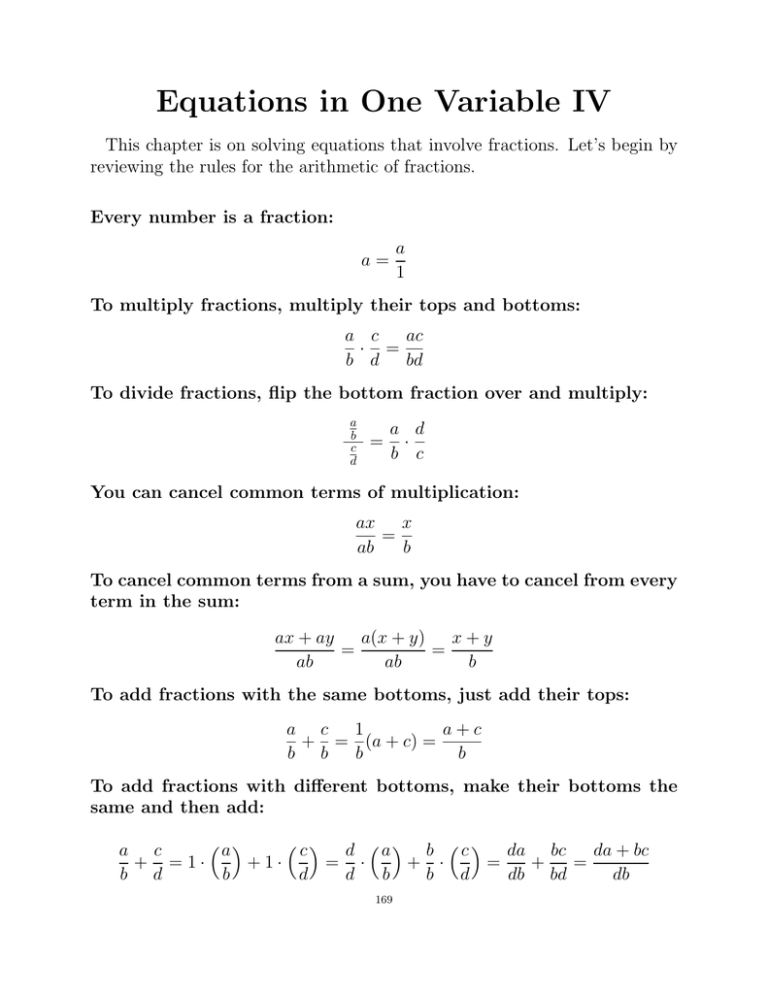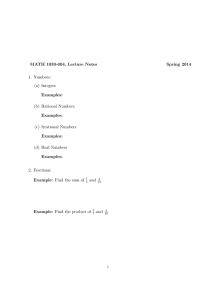Equations in One Variable IV
advertisement

Equations in One Variable IV This chapter is on solving equations that involve fractions. Let’s begin by reviewing the rules for the arithmetic of fractions. Every number is a fraction: a 1 a= To multiply fractions, multiply their tops and bottoms: ac a c · = b d bd To divide fractions, flip the bottom fraction over and multiply: a b c d = a d · b c You can cancel common terms of multiplication: ax x = ab b To cancel common terms from a sum, you have to cancel from every term in the sum: ax + ay a(x + y) x + y = = ab ab b To add fractions with the same bottoms, just add their tops: a+c a c 1 + = (a + c) = b b b b To add fractions with different bottoms, make their bottoms the same and then add: a c d a b c da bc a c da + bc + =1· +1· = · + · = + = b d b d d b b d db bd db 169 Simplifying fractions There isn’t a single step-by-step process that can be used to simplify complicated fractions such as 1 x + 5 x 3 x2 All you can do is look at the fraction, find some form of arithmetic that you know how to perform (for example, using one of the rules on the previous page), perform it, and then start the process over again. It might take several steps, but no single step is terribly complicated. Just look for two fractions that you can add. If you find two, add them. Look for two fractions that you can divide. If you find two, divide them. Keep in mind that every time you add two fractions, multiply two fractions, or divide two fractions, you are turning two fractions into one fraction. So each time you add, multiply, or divide fractions, you’ll have one less fraction lying around, and that’s usually a good thing. Keep going until you are left with something that looks pretty simple. Examples. • To simplify 1 x + 5 x 3 x2 notice that the numerator (the top) of the larger fraction is x1 + x5 .We know how to add these two fractions. Their sum is x6 . Thus, if we add the two smaller fractions in the numerator of the larger fraction we’ll have 6 x 3 x2 We added two fractions, and the expression that we are trying to simplify became simpler as a result. You might think that what we are left with is still a bit complicated, but it is simpler. We just need to make it simpler a couple of more times, and then we’ll be done. The expression that we are trying to simplify now is 170 6 x 3 x2 We can divide the fractions in the numerator and the denominator (the bottom) of this larger fraction using the rule on the previous page: flip the bottom fraction over and multiply. 6 6 x2 6x2 x = 3 = x 3 3x 2 x We divided two fractions that we knew how to divide, and the result was 2 6 3 simpler than what we started with. 6x 3x is simpler than x divided by x2 . We need to continue simplifying our original fraction 1 x + 5 x 3 x2 2 We know that it equals 6x 3x . The 3 in the denominator divides 6, and the 2 2 2x 2 result is 2. 6x 3x = x . The x in the denominator divides x , and the result is 2 x. 2xx = 2x. Therefore, 1 5 x + x = 2x 3 x2 and that’s the end of the simplification process. In some of the exercises, you’ll see complicated fractions, and you’ll need to simplify them to find your answers. To simplify a complicated fraction, just take it one step at a time. Maybe you’ll multiply two fractions, or maybe you’ll cancel a common term from the numerator and denominator of a fraction. You’ll continue one step at a time until you’re done. • We can begin to simplify 2x3 2 ( x3 )( x4 ) by multiplying the two smaller fractions in the denominator of the larger fraction: x2 x x2 x x3 = = 3 4 (3)(4) 12 171 Thus, we can rewrite our original expression as shown below: 2x3 2x3 = x3 2 ( x3 )( x4 ) 12 Remember, that 2x3 is a fraction if we want it to be. It’s the fraction Thus, we can simplify 2x3 2x3 1 . x3 12 using our rule for dividing fractions: 2x3 2x3 12 24x3 2x3 1 = 3 = x3 = 3 x3 1 x x 12 12 The last step would be to cancel the common term of x3 from the numerator 3 24 and denominator of 24x 3 x . The end result would be 1 = 24. We have seen that 2x3 = 24 2 ( x3 )( x4 ) Multiplying an equation by a denominator Some of the exercises in this chapter require you to simplify fractions. Others require the technique of multiplying by a denominator to remove fractions from an equation. We’ll illustrate this technique with a single example. Example. 4 • We can solve the equation x x+x−1 = 1 by multiplying both sides of 4 −3 4 4 the equation by x − 3, which is the denominator of x x+x−1 4 −3 . The resulting equation will have no fractions in it, and we can continue from there. First, we multiply by x4 − 3: x4 + x − 1 = (x4 − 3)(1) = x4 − 3 Then we subtract x4 : x − 1 = −3 Then we add 1: x = −2 Therefore, −2 is the only solution to the equation 172 x4 +x−1 x4 −3 = 1. Exercises Find the set of solutions of the following equations in one variable. 1.) 2x − 5 =3 x−1 2.) x2 = x+1 3.) (x − 3)(2x + 1)(x + 2) = 3x − 5 (x + 2)(x − 3) 4.) x2 + x + 1 =1 2x + 1 5.) x+1 x 1 x2 1 −x2 −x x =2 6.) x2 + 3 =1 x2 + 2x + 5 7.) 3x5 − 2x4 =0 x4 8.) 2x2 − 3x + 2 =2 x−3 9.) x3 +x2 +x x+1 1 x+1 + x =3 173



